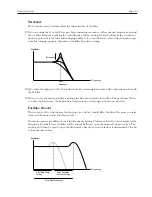
Page 48
Panel Reference
Amount
This is used to set to what extent the signal from the LFO should be routed to the destination.
Please note that the Amount can also be controlled from the Modulation wheel, see page 52.
LFO 2/Arpeggiator
Rate
▼
For conventional LFO effects (vibrato and tremolo), this is used to set how fast the LFO should run.
▼
When “Echo” is selected (see below), the Rate setting determines the “speed”, i.e. the delay-time between
each echo. A higher Rate setting gives a faster echo (shorter delay-time).
▼
When arpeggio is selected (see below) this adjusts the speed of the arpeggio.
The LFO rate/arpeggio speed can also be controlled externally, via MIDI, see page 61.
Destination
OSC 1+2:
When this is selected, LFO 2 produces a triangle wave routed to the pitch of Oscillator 1 and 2
in equal amounts – in other words, a regular vibrato.
Amp:
When this is selected, LFO2 produces a triangle wave routed to the volume, for tremolo effects.
Echo:
In this mode (“OSC1+2” and “Amplifier“ LEDs lit), LFO2 creates an echo-effect by using repeated
triggering with decreasing velocity (see explanation on the next page).
Arp Up:
In this mode, LFO 2 works as an arpeggiator. The keys pressed on the keyboard will be played
one after the other, from top to bottom, at a speed set with the Rate button. For more details, see Arp
Range below.
Arp Down:
As Arp Up but downwards.
Arp Up/Down:
To get an up/down arpeggio, press the Destination button until both Arp Up and Arp Down
are lit.
Rnd Arp:
In this mode (“ARP Up” and “Amp” LEDs lit), Nord Lead will create random arpeggios from the
chords you play on the keyboard. This means that the notes in the chord are played back one at a time,
but in random order and in random octaves.
2
3
4
ARP UP
ARP DOWN
AMP.
ECHO
RND
ARP
Amt / Arp range
Rate
LFO 2 / Arpeggiator
OCT 1
OFF
OSC 1+2
Summary of Contents for nord lead
Page 1: ...Owners Manual Software Version 2 x English Clavia DMI AB 1996...
Page 6: ...Page 4 Table Of Contents...
Page 8: ...Page 6 Introduction...
Page 22: ...Page 20 Basic Operations...
Page 74: ...Page 72 MIDI...
Page 90: ...Page 88 About Subtractive Synthesis...
Page 110: ...Page 108 MIDI Implementation Chart...
Page 114: ...112 Index...









































